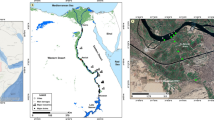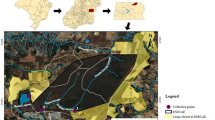Abstract
The aim of this research was to study the effects on streams water quality of non-point contamination as agriculture and cattle farming activities at a basin with pampean characteristics located at the upper Reconquista River Basin. Eight reaches with different uses in their neighboring zones were selected with the proposed to detect differences at the water quality among them. SRP range was 0–0.60 mgP.PO −34 /L, ammonia 1–137.3 μgN-NH4+/L and nitrate 0–4.15 mgN-NO3 −/L. There was high similitude and homogeneous physicochemical characteristics at the different reaches of the streams. The high levels of dissolved nutrients showed similar eutrophication conditions at the streams.
Similar content being viewed by others
Explore related subjects
Discover the latest articles, news and stories from top researchers in related subjects.Avoid common mistakes on your manuscript.
Eutrophication of rivers is a problematic of international concern. The undesirable symptoms of eutrophication in rivers occur primarily at low flows during the growing season when higher water residence times, abundant light levels and high water temperatures promote rapid algal growth (Mainstone and Parr 2002). This is driven by diffuse nutrient inputs in storm runoff from intensively managed agricultural land. A similar behavior can be observed with the diffuse organic matter and sediment inputs from cattle farming (Jarvie et al. 2006). The characteristics of water bodies that promote eutrophication are generally found in pampean streams. Pampean streams developed in grasslands with scarce slopes and low flow conditions. Few recent studies carried out in the streams of the Pampean region focused on the concentration of nutrients and other elements transported in surface run-off and sub-surface drainage water (Arreghini et al. 2005; Mugni et al. 2005).
The study was carried out in eight reaches of streams of the Reconquista basin, in Buenos Aires, Argentina. The Reconquista River is a relatively warm water course that develops in the pampas. It is originated by the confluence of the Durazno, La Choza and La Horqueta streams at the Roggiero dam, and finally joins the Luján river, which runs into the Río de La Plata estuary, where Buenos Aires city extracts water for drinking. These streams are neighbors to fields where there are extensive cattle farming and cultures of corn and soybean. The aim of this research was to study the effects on streams water quality of non-point contamination as agriculture and cattle farming activities at a basin with pampean characteristics.
Materials and Method
In this study, eight sampling reaches were selected on the upper Reconquista river basin. Three reaches were located at the La Choza stream, two at the Durazno stream, and one at the Durazno Chico, Arias and Nutrias streams (Fig. 1). Six seasonal sampling surveys were carried out between December 2006 and March 2008. The fields adjacent to the La Choza III and Durazno II reaches are devoted to agricultural activities, whereas the fields adjacent to the reach La Choza II is devoted to both agricultural and cattle farming activities. La Choza I, Arias, Nutrias, Durazno I and Durazno Chico are cattle farming areas.
Water flow was estimated using the velocity-area method according to Gordon et al. (1992). The current velocity was measured with Propeller flowmeter General Oceanics 2030R (Miami, USA). Dissolved oxygen, conductivity and pH field measurements were recorded with Portable Hanna instruments (Woonsocket, USA). Collection and analyses of water samples were performed in triplicate and conducted according to APHA (2005). The variables analyzed were Soluble Reactive Phosphorous (SRP), Ammonium, Nitrites, Nitrates, Chlorides, Chemical oxygen demand (COD), Biological oxygen demand (BOD), Alkalinity, Inorganic and Organic suspended particulate matter. Humic acid was estimated according to Lavado et al. (1982).
Statistica 6.0 ® was used in every statistical analysis. The variables which did not conform to the assumption of normality were transformed into logarithms. Normality was tested using the Kolmogorov–Smirnov test. There are carried out correlations among the variables and ANOVA analysis to compare the reaches results. Principal Component Analyses (PCA) included every physico-chemical variable except those associated with the water flow to avoid redundancy.
Results and Discussion
Water composition is associated with the characteristics and degree of conservation of terrestrial ecosystems. Margalef (1994) asserts that the interaction between continental waters and the terrestrial ecosystem reflects the general condition of their basins. Consequently, the non-point sources caused by rural activities may be detected at the neighboring reaches and should influence the eutrophication processes at the basin. Today, due to the expansion of agriculture, Pampean streams suffer the marginalization of cattle to the riparian zone, which leads to its destruction by trampling. This destruction favors the loss of infiltration capability and the input of nutrients and solid particles at the streams.
This study is the first in evaluate non-point contamination in streams of Reconquista river upper basin. Table 1 shows the results of the various surveys and the means and standard deviations for each site. These results evidence high variation at the range of values of each variable promoted by more important seasonal than reaches differences. There was a great variability of nutrient, suspended solids and conductivity between sites: SRP range was between 0 to 0.60 mgP.PO −34 /L, ammonia varied between 1 and 137.3 μgN-NH4+/L and nitrate between 0 and 4.15 mgN-NO3 −/L. The high levels of SRP, ammonia and nitrate reflect eutrophication processes at the streams. Biocides at water and sediment were analyzed in two sampling occasions but we do not found these components. Probably there were transformed in metabolites or residual components. Then, these components could not be recorded or have not even arrived to the stream, because there were few years of developed of agricultural practices in upper basin.
Urea, phosphates and nitrates are the main form of fertilizations added and therefore, the main non-point waste (Haygarth et al. 2005). The soils of this Pampean zone have scarce structure because of the abundance of sodium ions. This characteristic, along with bare riparian zones due to the action of biocides, promotes an eutrophication process at the upper Reconquista basin because bare soils increase the runoff rate and the horizontal and vertical particle movements (Chagas et al. 2004). Arreghini et al. (2005) advised that it is necessary to apply more efficient fertilization strategies in order to reduce the nutrient load in the pampean region. It is necessary to promote the control of the phosphorus levels used in the fields to avoid the eutrophication effect in superficial water bodies and to control nitrogen levels to avoid groundwater contamination.
Despite the different land uses there were no significant differences in the physicochemical variables between reaches (ANOVA). Only reaches adjacent to cattle farming fields tended to present greater amounts of humic acids and suspended solids. An analysis of the different variables considered at the reaches was carried out by a multivariate (PCA) analysis. The first three components of this analysis explained 31.5, 19.19 and 11.65% of the total variance (62. 34%) respectively. The first component (eigenvalue: 4.72) showed a positive correlation with humic acid level (coefficient: 0.83) and COD (0.80), and a negative correlation with conductivity (−0.82), alkalinity (−0.8), pH (−0.73) and chloride concentration (−0.72). The second component (eigenvalue: 2.88) had a positive correlation with both the particulate material estimated as gDW/L (0.93) and that estimated as gAFDW/L (0.9), and a negative correlation only with flow (−0.78) (Fig. 2). Thus, there are reaches with high levels of humic acids and COD and others with high soluble solids. To visualize the reaches distribution at each sampling occasion, we represented the scores of the two first components (Fig. 3) and observed that the reaches at December appeared differentiated of the others (rounded rectangle in Fig. 3). This date was the sampling opportunity with most flow.
Jarvie et al. (2008) asserts that high SRP concentrations indicate a non-point source of SRP mobilized under high flows but, other authors have demonstrated that cattle farming also contribute to phosphorus content (Withers et al. 2007). Nitrogen, mainly as nitrates, also increases in highflow conditions. Jarvie et al. (2008) reported an increase in nitrate concentrations corresponding with the onset of higher flows, which led to high nitrate concentrations. Pionke et al. (1999) reported that the nitrate concentrations were lowest at baseflow (5.36 mg/L) and highest at high flow (7.12 mg/L). Therefore, this study demonstrates homogeneous physicochemical characteristics at the different reaches of the streams. This could be explained by the dragging of solutes from the neighboring soils because diffuse runoff is mobilized during rainfall events but also by the cattle activities near or into the streams.
In the sampling occasions with normal flow the cattle farming reaches generally locate at the right side of the graph while the agricultural ones locate at the left side of the graph. Cattle farming reaches generally present more COD and humic acids at the waters while agriculture seems to increase the conductivity, pH and dissolved oxygen (Fig. 2, 3). However, the similar increase in phosphorus, ammonia and particulate material at both rural activities led to the homogenization of eutrophication process and water quality at the studied streams.
References
APHA (American Public Health Association) (2005) Standard methods for the examination of water and wastewater. APHA, Washington DC
Arreghini S, de Cabo L, Seoane R, Tomazin N, Serafíni R, de Iorio A (2005) Influence of rainfall on the discharge, nutrient concentrations and loads of a stream of the “Pampa Ondulada” (Argentina). Limnetica 24:225–236
Chagas CI, Irurtia C, Thisted J, Santanatoglia OJ, Massobrio MJ, Castiglioni MG, Bujan A (2004) Horizontal and vertical movement of water and particles in a no-till argiudol. Ciencia del Suelo 22:117–122
Gordon BN, Mc Mahon TA, Finlayson BL (1992) Stream hydrology: an introduction and for ecologists. John Wiley & Sons, New York
Haygarth PM, Condron LM, Heathwaite AL, Turner BC, Harris JP (2005) The Phosphorous transfer continuum: linking source to impact with and interdisciplinary and multiscaled approach. Sci Total Environ 344:5–14
Jarvie H, Neal C, Withers P (2006) Sewage-effluent phosphorus: a greater risk to river eutrophication than agricultural phosphorus? Sci Total Environ 360:246–253
Jarvie H, Withers P, Hodgkinson R, Bates A, Neal M, Wickham H, Harman S, Armstrong L (2008) Influence of rural land use on stream water nutrients and their ecological significance. J Hydrol 350:166–186
Lavado R, Duymovich O, Jiménez J, Alvarez L (1982) Loss of nitric soil humic substances through Samborombón River. Rev. Mus. de la Plata IX, Geología. 76:97–103
Mainstone CP, Parr W (2002) Phosphorus in rivers: ecology and management. Sci Total Environ 282–283:31–36
Margalef R (1994) The global river. Tankay 1:3–12
Mugni H, Jergentz S, Schulz R, Maine A, Bonetto C (2005) Phosphate and nitrogen compounds in sreams of Pampean Plain areas under intensive cultivation (Buenos Aires, Argentine). In: Serrano L, Golterman HL (ed) Proceeding of 4th International Symposium of Phosphates in Sediments, The Netherlands
Pionke HB, Gburek WJ, Schnabel RR, Sharpley AN, Elwinger GF (1999) Seasonal flow, nutrient concentrations and loading patterns in stream flow draining an agricultural hill-land watershed. J Hydrol 220:62–73
Withers P, Hodgkinson R, Adamson H, Green G (2007) The impact of pasture improvement on phosphorus concentrations in soils and streams in an upland catchment in Northern England. Agric Ecosyst Environ 122:220–232
Acknowledgments
This study was supported by PICT No: 26-165/04 and Universidad Nacional de Luján. We thank P. Castañé, F. de la Torre, P. Scarcia, and N. Ossana for their collaboration in the field surveys.
Author information
Authors and Affiliations
Corresponding author
Rights and permissions
About this article
Cite this article
Vilches, C., Giorgi, A., Mastrángelo, M. et al. Non-point Contamination Homogenizes the Water Quality of Pampean Streams. Bull Environ Contam Toxicol 87, 147–151 (2011). https://doi.org/10.1007/s00128-011-0312-1
Received:
Accepted:
Published:
Issue Date:
DOI: https://doi.org/10.1007/s00128-011-0312-1







